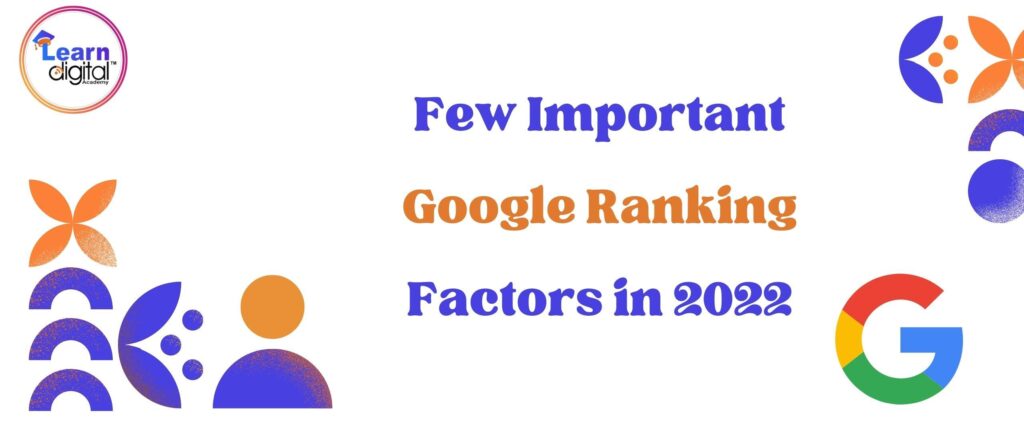
Google is a very powerful search engine. It is the world’s most popular search engine and it has a lot of power in ranking factors. But to become a top result in any of the SERP types of websites, you need to have some of the Google SEO factors that are considered important.
Some factors such as the website content, the page content, its structure, its links, and the use of the right keywords in the meta descriptions, descriptions, etc. are considered to be important in Google SEO. Let us examine these factors from the viewpoint of SEO practitioners.
The Google SEO Factors
Google has a very good algorithm for its SEO. The website owner also needs to have good content, a good page, and a good structure. If the website has good quality content, it will be ranked high in the SERPs. The structure of the page is very important for SEO. When we think about page content optimization, we talk mainly about the content of the pages which is considered as the main factor for the Google rankings. The meta description is also an important factor for Google rankings because it determines the organic results. Websites need to optimize their meta descriptions a lot. It contains important information for website visitors. The links from the websites are also important because they can contribute to organic traffic. The use of the right keywords is also important for Google SEO because it helps the website to get higher rankings.
The page content and website content need to be optimized very carefully. The most important method is to use the right words in the content. The words in the content need not be very long. The right words are those that are used frequently. The language should be simple and it should be easy to understand.
The text should be short and it can be written using the right language. Inappropriate words or grammar in the text also leads to errors which in turn decrease the rankings of the website. One more thing to keep in mind is that the optimized page content should not be too long. If we write a long text, it would slow down the loading of the webpage. This can increase the loading time of the web page. So, it is better to write a very short text.
So, one of the best ways to ensure that we are making full use of the content is by improving the search engine optimization (SEO) efforts. This BLOG will mainly focus on how to produce better SEO in 2021 and rank higher on Google in detail.
The Google SEO Factors:
1. High-Quality Content
As we all know that content is king. And within the case of Google ranking factors, it is undoubtedly the king. If you create content that is unique, fresh, then Google will rank it higher on SERPs. If your content is not unique, then we can’t expect a higher ranking in google. Below points are the key factors for quality content that are required for Google ranking to rank your website in Google.
- Original, Unique, and Valuable Content
- Up to Date and Fresh Content
- Content-Length
- Content Structure and Organization

2. Backlinks
After content, the second most significant Google ranking factor is backlinks.
They are a crucial part of Google’s ranking algorithm and it is how Google
crawler finds your website for indexing. As we know, content and backlinks go hand in hand, as webpages without any backlinks hardly get any organic traffic. Backlinks or inbound links are crucial for your site’s SEO as they are like a vote of confidence for your website. Google adds all those votes together and checks if your website deserves to rank within the top 10 results.

3. Search Intent
Another crucial ranking factor for Google is to relate with the search intent of the content. Search intent is essentially what a user is searching for. Every keyword is different on Google and you need to know the need or importance behind that search query.

For example, if someone searches for the Best SEO Training institute in Bangalore, you’ll notice that the results consist of details of the top Institutes or Training Centres or online courses, tips and tricks along with videos to improve SEO.

Another example is that, if you search the keyword, Learn digital, you’ll notice that the results consist of addresses and reviews of the Institute we entered.

So, if you were to make content on either of the topics, it is essential to correlate with the search intent and create the proper form of content. Now, search intent could vary supported content format and magnificence. For example, in some cases, Google will display only videos and infographics within the top results.
4. Website Loading Speed
Among different Google ranking factors, another factor we must target is our page speeds. That’s because starting May 2021, Google will make website loading speed part of its Core Web Vitals.
These are a collection of things that Google considers are important for user experience on your site. it’ll examine the speed, responsiveness, and the way quickly different elements like fonts and pictures load.
Now the main goal here is to concentrate on how briskly a page loads for your users. Google wants your website to load quickly and supply an excellent user experience for your audience.

5. Keyword Optimization
Other than creating content and getting backlinks, the foremost obvious ranking factor is the use of keywords on the website. Keywords are the
search terms users use to appear up things on Google. So, it is very important that your website must contain the keywords your audience is attempting to
find. That way, Google can remark your page in its search results. To ensure that your website is keyword optimized, here are a few important things:
- Title Tags – Include target keyword at the beginning of the posts SEO title tags.
- Meta Description – Write irresistible meta descriptions and add the required focus keyword, so that the users will know what the page is about and clicks on it.
- Image Alt Text – As we know Google cannot read images, we have to add the keywords within the image alt text section to inform what the visual is all about.
- Anchor Text – Google will use anchor text to search out what’s the page
is all about, so we have to use the keywords for anchor text while linking the pages.
- Use of LSI (latent semantic indexing) Keywords – By including this keyword on our page, we are helping Google to check out what the content is about.
- Adding Keyword in URL – Another keyword optimization practice is to incorporate the keyword within the URL of the post.

6. Mobile Friendliness
Other than speed, another important thing to notice is whether the site is mobile-friendly or not.
Google has gone mobile-first which means Google will now use the website’s mobile version for indexing and ranking. Previously, Google would use the desktop because it was the primary version for indexing. But with more mobile internet users within the world, it’s no surprise that Google has made this new change. So, if you want to spice up the rankings, then the most effective way is to create the website in mobile-friendly mode.

7. Website Security
Along with website architecture, the site’s security is now a key Google ranking factor. This is when you need to ensure that the site is on HTTPS, as it encrypts the information between the website and the user’s browser.

8. User Experience
Lastly, another Google ranking factor is the overall user experience of the website. There are generally a lot of things that contribute towards a good user experience.
How does Google usually measure this?
It uses an artificial intelligence program called RankBrain, which includes other ranking signals like:
- CTR (click-through-rate) – It means the percentage of clicks that a user clicks on a webpage. CTR is usually measured as a percentage of the number of clicks on the webpage divided by the number that the user clicks. By improving this, we can boost our rankings.
- Bounce Rate – High bounce rate isn’t good for a site. If high number of individuals click on a particular site and then hit the back button without interacting with that website, then Google will think that the page is not relevant and won’t rank it.
- Dwell Time – The higher the dwell time, the better it is. This checks how long a visitor stays on the site after coming from the top search results.

While these are just a few important ranking signals Google’s RankBrain uses, there are many more. But since most of them are speculations at this stage, I won’t get into them here. But the key thing to remember is that they are all pretty much interrelated.
Google RankBrain is a very complex algorithm that is designed to use all these signals and make a prediction for the user. It also uses a variety of other data to understand a user and their preferences. The only way to know whether Google RankBrain will work for you or not is to test it. This blog has covered some of the best techniques to test the algorithm and get a sense of how it works. To sum it up, RankBrain works based on the idea of understanding user behavior and matching it to content. If you are a regular user of a website, you will probably get a good sense of what content is relevant to you. If not, you can still use these techniques to figure out where your interests lie and build a custom plan.
The best way to test RankBrain for yourself is to use the Google Search Console. Google Search Console is a tool that allows you to test your search results against the Google algorithm. You can also use it to analyze the performance of your website. I have tested the Google Rank Brain tool and found it to be a very useful tool that I use every day.
If you are looking for a tool to analyze your website, I recommend you use the Google Search console. Also, I have used the Google Ranking Insights tool to help me analyze content. You can use it as a tool for content analysis or see how your website is performing. I am not an expert on the topic, so I can’t give you a definitive answer on whether Google’s RankBrain algorithm Is working for you. But you can use these tools to get a feel for how it is working and what you can do to make it work for your website or the site’s keywords. Also, you should use these to see if you are getting good results for your keywords in search results. The tool can show you how competitive your keywords are in the SERP.
You can see how many times your keywords appear in the search results and how many pages they appear on. You will also see how often they appear in search result snippets.



